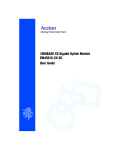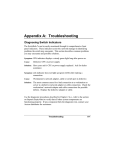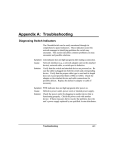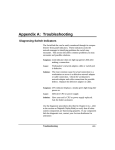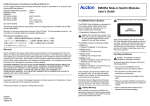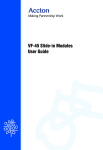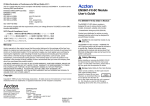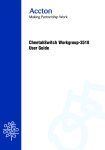Download Edge-Core ES4005V network switch
Transcript
Powered by Accton 5/8-Port Gigabit Switch ES4005V ES4008V Installation Guide www.edge-core.com Quick Installation Guide 5-Port Gigabit Ethernet Switch Gigabit Ethernet Switch with 5 10BASE-T / 100BASE-TX / 1000BASE-T (RJ-45) Ports 8-Port Gigabit Ethernet Switch Gigabit Ethernet Switch with 8 10BASE-T / 100BASE-TX / 1000BASE-T (RJ-45) Ports ES4005V ES4008V E032005-R01 150000017400H Contents Introduction Features and Benefits Front Panel RJ-45 Ports LEDs ES4005V ES4008V Rear Panel 1 1 1 2 2 2 2 Installing the Switch Package Contents Selecting a Site Instructions Applications 3 3 3 3 4 Product Specifications Physical Characteristics Switching Criteria 6 6 6 Troubleshooting Diagnosing Switch Indicators Power and Cooling Problems Installation 7 7 7 7 Cables Cable Specifications 10BASE-T/100BASE-TX Pin Assignments 1000BASE-T Pin Assignments 1000BASE-T Cable Requirements Cable Testing for Existing Category 5 Cable Adjusting Existing Category 5 Cabling 8 8 8 9 9 9 10 EMI Certification FCC Class B Certification (USA) Canada Department of Communications – Class B CE Mark Declaration of Conformance for EMI and Safety (EEC) 10 10 10 11 Safety Compliance 12 i Contents ii Introduction These switches are high-performance Gigabit Ethernet switches designed for delivering Gigabit connectivity to the desktop. They provide 5/8 full-duplex 1000BASE-T ports that significantly improve network performance and boost throughput for high-bandwidth applications. With 10/16 Gigabits of aggregate bandwidth, these switches provide the quickest solution to meeting the growing demands on your network's limited resources. Features and Benefits • Auto-negotiation supported on all ports • Automatic MDI/MDI-X operation • IEEE Std 802.3-2002 compliance ensures compatibility with standards-based hubs, switches and cards from any vendor • Store-and-forward switching ensures error-free transmission • Half- and full-duplex flow control prevents packets from being dropped under heavy loading • Plug-and-play nothing to configure • “At-a-glance” LEDs for port and system status monitoring • Desktop installation Front Panel RJ-45 Ports These switches feature 5/8 1000BASE-T ports with RJ-45 connectors located on the rear panel of the switch. Because all ports support automatic MDI/MDI-X operation, you can use straight-through cables for all network connections to PCs or servers, or to other switches or hubs. 1 Introduction LEDs The front panel of the switch provides status LEDs for “at-a-glance” system monitoring. The following table details the functions of the various indicators. LED Power Ports Link/Act Port and System Status LEDs Condition Status On The switch is receiving power. Off The switch is not receiving power. On Off 1000M Flashing On Off The port has established a valid network connection. The port has not established a network connection. Traffic is passing through the port. Indicates the port is operating at 1000 Mbps. Indicates the port is not operating at 1000 Mbps. ES4005V ES4008V Rear Panel The DC power receptacle is located on the rear panel of the switch. 2 Package Contents Installing the Switch Before installing the switch, verify that you have all the items listed under “Package Contents.” If any of the items are missing or damaged, contact your local Accton distributor. Also be sure you have all the necessary tools and cabling before installing the switch. Note that the switch can be installed on any suitable large flat suface. Package Contents This package includes: • 5/8-Port Gigabit Ethernet Switch (ES4005V or ES4008V) • Four rubber foot pads • Appropriate DC power adapter • This User Guide Selecting a Site Be sure to follow the site selection guidelines below when choosing a location: • Select a suitable location for the switch: • It should be accessible for installing, cabling and maintaining the switch. • The temperature and humidity should be within the ranges listed in the specifications. • The status LEDs should be clearly visible. • There should be adequate space (approximately two inches) on all sides for proper air flow. • Make sure twisted-pair cable is always routed away from power lines, fluorescent lighting fixtures and other sources of electrical interference such as radios, transmitters, etc. • Make sure that a properly grounded power outlet is within 1.83 meters (6 feet) of the switch and is powered from an independent circuit breaker. As with any equipment, using a filter or surge suppressor is recommended. Instructions 1. 2. Positioning the Switch: For desktop or shelf mounting, attach the four adhesive foot pads to the bottom of the switch. Applying Power: Plug one end of the power adapter into the socket on the switch's rear panel, and the other end into an appropriate electrical outlet. Check the Power LED to be sure power is on. Note: It is not necessary to power off the switch before connecting or disconnecting any UTP cables, as these actions will not disrupt the operation of other devices attached to the switch. 3 Installing the Switch 3. Connecting PCs: Connect each PC to an RJ-45 port on the switch using Category 5, 5e, or 6 shielded or unshielded twisted-pair (UTP or STP) cable, maximum length 100 meters (328 ft). Switch 10/100/1000 will support up to 5/8 PCs. All ports on the switch support automatic MDI/MDI-X operation, so you can use straight-through cables for all network connections to PCs or servers, or to other switches or hubs. Note: If an attached device does not support auto-negotiation, the data rate will be sensed automatically and the communication mode will default to half duplex. (All 1000BASE-T devices should support auto-negotiation, so this behavior only applies to slower devices which do not support, or have disabled, autonegotiation.) 4. Cascading Switches and Other Network Devices: All the ports on the switch support automatic MDI/MDI-X configuration for cable connections. This allows you to use straight-through cable to connect to other switches or hubs from any port on the switch. No crossover cables or other device settings are needed. See the “Cable Specifications” on page 8 of this guide for further information. Caution: Do not plug a phone jack connector into any RJ-45 port. This may damage the switch. Instead, use only twisted-pair cables with RJ-45 connectors that conform with FCC standards. Applications This switch segments your network, significantly increasing both bandwidth and throughput. Each port on the switch can be attached to any Ethernet, Fast Ethernet, or Gigabit Ethernet device, such as another switch, or a server’s network adapter. All switch ports operate at 10 /100 Mbps full and half duplex, or 1000 Mbps full duplex, providing up to 2 Gbps of bandwidth to the attached device. Bridging Functions – This switch provides fully transparent bridging functions. It automatically learns node addresses, that are subsequently used to filter and forward all traffic based on the destination address. When traffic passes between devices attached to the same shared collision domain, those packets are filtered from the switch. But when traffic must be passed between unique segments (i.e., different ports on the switch), the high-speed switching fabric forwards the packets at near zero latency. Switching Functions – Store-and-forward switching is used to forward traffic to other ports. This scheme ensures data integrity and provides a clean data stream. Sample Application – This switch is designed to operate as a small workgroup switch. It can provide 10, 100, or 1000 Mbps connections to workstations, or 1000 Mbps full-duplex links to high-speed servers. It can also provide a high-bandwidth uplink to the network backbone. 4 Applications V 100 Mbps 10 Mbps 100 Mbps 1000 Mbps 100 Mbps Server 10 Mbps Workstations 100 Mbps Workstation 1000 Mbps Workstation Standalone LAN V V 100 Mbps Servers 100 Mbps Workstations 1000 Mbps Workstation 100 Mbps Server 1000 Mbps Workstation 10 Mbps Segment 100 Mbps Segment Cascading Switches 5 Product Specifications Product Specifications Physical Characteristics Standards Conformance Communication Rate Communication Mode Media Supported Number of Ports Indicator Panel Dimensions Weight DC Input Power Power Consumption Temperature Humidity Immunity Emissions Safety IEEE Std 802.3-2002 10. 100, and 1000 Mbps Full or half duplex at 10/100 Mbps Full duplex at 1000 Mbps 10BASE-T: 100-ohm Category 3 or better twisted-pair 100BASE-TX: 100-ohm Category 5 or better twisted pair 1000BASE-T: 100-ohm Category 5, 5e, or 6 twisted-pair ES4005V: 5 RJ-45 1000BASE-T ports ES4008V: 8 RJ-45 1000BASE-T ports Power Ports: Link/Act, 1000 Mbps ES4005V: 13.0 x 8.56 x 31.9 cm (5.15 x 3.38 x 1.26 in.) ES4008V: 17.46 x 8.6 x 3.29 cm (6.9 x 3.4x 1.3 in.) ES4005V: 275 g (0.606 lb) ES4008V: 375 g (0.827 ib) 9V, 1A All 9 Watts maximum Operating: 0 ~ 40 ºC / 32 ~ 98 ºF Storage: -40 ~ 70 ºC / -40 ~ 158 ºF 10% to 90% non-condensing EN 61000-4-2/3/4/5/6/8/11 FCC Class B, CISPR Class B, EN 61000-3-2/3 CSA/CUS (CSA60950-1 & UL60950-1) TÜV/GS (EN60950-1) CB (IEC60950-1) Switching Criteria Network Bridging Function Filtering, forwarding and learning Switching Method Store-and-forward MAC Address Table ES4005V: 4K entries ES4008V: 8K entries Packet buffer ES4005V: 112 KBytes ES4008V: 144 KBytes 6 Troubleshooting Diagnosing Switch Indicators Symptom Power LED does not light after power on. Probable Causes DC power adapter may be defective. Possible Solutions • Check for loose connections. • Check the power outlet by using it for another device. • Replace the DC power adapter. Symptom Port (link) LED does not light after connection is made. Probable Causes Switch port, network card or cable may be defective. Possible Solutions • Check that the switch and attached device are both powered on. • Be sure the network cable is connected to both devices. • Verify that Category 5 or better cable is used for 10/100 Mbps connections, Category 5, 5e, or 6 cable for 1000 Mbps connections, and that the length of any cable does not exceed 100 meters (328 feet). • Check the network card and cable connections for defects. • Replace the defective card or cable if necessary. Power and Cooling Problems If the power indicator does not turn on when the power cord is plugged in, you may have a problem with the power outlet, power cord, or internal power supply as explained in the previous section. However, if the unit powers off after running for a while, check for loose power connections, power losses or surges at the power outlet, and verify that the fans on the right side of the unit are unobstructed and running prior to shutdown. If you still cannot isolate the problem, then the internal power supply may be defective. Installation Verify that all system components have been properly installed. If one or more components appear to be malfunctioning (e.g., the power cord or network cabling), test them in an alternate environment where you are sure that all the other components are functioning properly. 7 Cables Cable Specifications Cable Types and Specifications Cable Type Max. Length Connector 10BASE-T Cat. 3, 4, 5 100-ohm UTP 100 m (328 ft) RJ-45 100BASE-TX Cat. 5 100-ohm UTP 100 m (328 ft) RJ-45 1000BASE-T Cat. 5, 5e, 6 100-ohm UTP 100 m (328 ft) RJ-45 Caution: DO NOT plug a phone jack connector into any RJ-45 port. Use only twisted-pair cables with RJ-45 connectors that conform with FCC standards. 1 8 8 1 Use 100-ohm unshielded twisted-pair (UTP) or shielded twisted-pair (STP) cable for RJ-45 connections: Category 3, 4, or 5 cable for 10 Mbps connections, Category 5, 5e cable for 100 Mbps connections, or Category 5, 5e or 6 for 1000 Mbps connections. Also be sure that the length of any twisted-pair connection does not exceed 100 meters (328 feet). 10BASE-T/100BASE-TX Pin Assignments Because all ports on this switch support automatic MDI/MDI-X operation, you can use straight-through cables for all network connections to PCs or servers, or to other switches or hubs. In straight-through cable, pins 1, 2, 3, and 6, at one end of the cable, are connected straight through to pins 1, 2, 3 and 6 at the other end of the cable. The table below shows pinout signals for connections to 10BASE-T/100BASE-TX devices. 8 Pin MDI-X Signal Name MDI Signal Name 1 Receive Data plus (RD+) Transmit Data plus (TD+) 2 Receive Data minus (RD-) Transmit Data minus (TD-) 3 Transmit Data plus (TD+) Receive Data plus (RD+) 6 Transmit Data minus (TD-) Receive Data minus (RD-) 4,5,7,8 Not used at 10/100 Mbps Not used at 10/100 Mbps 1000BASE-T Pin Assignments The table below shows the 1000BASE-T MDI and MDI-X port pinouts. These ports require that all four pairs of wires be connected. Note that for 1000BASE-T operation, all four pairs of wires are used for both transmit and receive. Use 100-ohm Category 5 or 5e unshielded twisted-pair (UTP) or shielded twistedpair (STP) cable for 1000BASE-T connections. Also be sure that the length of any twisted-pair connection does not exceed 100 meters (328 feet). Pin MDI-X Signal Name MDI Signal Name 1 Bi-directional Data Two Plus (BI_D2+) Bi-directional Data One Plus (BI_D1+) 2 Bi-directional Data Two Minus (BI_D2-) Bi-directional Data One Minus (BI_D1-) 3 Bi-directional Data One Plus (BI_D1+) Bi-directional Data Two Plus (BI_D2+) 4 Bi-directional Data Four Plus (BI_D4+) Bi-directional Data Three Plus (BI_D3+) 5 Bi-directional Data Four Minus (BI_D4-) Bi-directional Data Three Minus (BI_D3-) 6 Bi-directional Data One Minus (BI_D1-) Bi-directional Data Two Minus (BI_D2-) 7 Bi-directional Data One Plus (BI_D3+) Bi-directional Data One Plus (BI_D4+) 8 Bi-directional Data Three Minus (BI_D3-) Bi-directional Data Four Minus (BI_D4-) 1000BASE-T Cable Requirements All Category 5 UTP cables that are used for 100BASE-TX connections should also work for 1000BASE-T, providing that all four wire pairs are connected. However, it is recommended that for all critical connections, or any new cable installations, Category 5e (enhanced Category 5) cable should be used. The Category 5e specification includes test parameters that are only recommendations for Category 5. Therefore, the first step in preparing existing Category 5 cabling for running 1000BASE-T is a simple test of the cable installation to be sure that it complies with the IEEE 802.3ab standards. Cable Testing for Existing Category 5 Cable Installed Category 5 cabling must pass tests for Attenuation, Near-End Crosstalk (NEXT), and Far-End Crosstalk (FEXT). This cable testing information is specified in the ANSI/TIA/EIA-TSB-67 standard. Additionally, cables must also pass test parameters for Return Loss and Equal-Level Far-End Crosstalk (ELFEXT). These tests are specified in the ANSI/TIA/EIA-TSB-95 Bulletin, “The Additional Transmission Performance Guidelines for 100 Ohm 4-Pair Category 5 Cabling.” Note that when testing your cable installation, be sure to include all patch cables between switches and end devices. 9 EMI Certification Adjusting Existing Category 5 Cabling If your existing Category 5 installation does not meet one of the test parameters for 1000BASE-T, there are basically three measures that can be applied to try to correct the problem: 1. 2. 3. Replace any Category 5 patch cables with high-performance Category 5e cables. Reduce the number of connectors used in the link. Reconnect some of the connectors in the link. EMI Certification FCC Class B Certification (USA) Warning: This equipment generates, uses, and can radiate radio frequency energy and, if not installed and used in accordance with the instruction manual, may cause interference to radio communications. It has been tested and found to comply with the limits for a Class B digital device pursuant to Subpart B of Part 15 of FCC Rules, which are designed to provide reasonable protection against such interference when operated in a commercial environment. Operation of this equipment in a residential area is likely to cause interference, in which case the user, at his own expense, will be required to take whatever measures are required to correct the interference. You may use unshielded twisted-pair (UTP) for RJ-45 connections - Category 3 or greater for 10 Mbps connections, Category 5 for 100 Mbps connections and Category 5, 5e, or 6 for 1000 Mbps connections. Canada Department of Communications – Class B This digital apparatus does not exceed the Class B limits for radio noise emissions from digital apparatus as set out in the interference-causing equipment standard entitled “Digital Apparatus,” ICES-003 of the Department of Communications. Cet appareil numérique respecte les limites de bruits radioélectriques applicables aux appareils numériques de Classe B prescrites dans la norme sur le matériel brouilleur: “Appareils Numérques,” NMB-003 édictée par le ministère des Communications. 10 CE Mark Declaration of Conformance for EMI and Safety (EEC) This information technology equipment complies with the requirements of the Council Directive 89/336/EEC on the Approximation of the laws of the Member States relating to Electromagnetic Compatibility and 73/23/EEC for electrical equipment used within certain voltage limits and the Amendment Directive 93/68/EEC. For the evaluation of the compliance with these Directives, the following standards were applied: RFI • Limit class B according to EN 55022:1998 Emission: • Limit class A for harmonic current emission according to EN 61000-3-2/1995 • Limitation of voltage fluctuation and flicker in low-voltage supply system according to EN 61000-3-3/1995 Immunity: • Product family standard according to EN 55024:1998 • Electrostatic Discharge according to EN 61000-4-2:1995 (Contact Discharge: ±4 kV, Air Discharge: ±8 kV) • Radio-frequency electromagnetic field according to EN 61000-4-3:1996 (80 - 1000 MHz with 1 kHz AM 80% Modulation: 3 V/m) • Electrical fast transient/burst according to EN 61000-4-4:1995 (AC/DC power supply: ±1 kV, Data/Signal lines: ±0.5 kV) • Surge immunity test according to EN 61000-4-5:1995 (AC/DC Line to Line: ±1 kV, AC/DC Line to Earth: ±2 kV) • Immunity to conducted disturbances, Induced by radiofrequency fields: EN 61000-4-6:1996 (0.15 - 80 MHz with 1 kHz AM 80% Modulation: 3 V/m) • Power frequency magnetic field immunity test according to EN 61000-4-8:1993 (1 A/m at frequency 50 Hz) • Voltage dips, short interruptions and voltage variations immunity test according to EN 61000-4-11:1994 (>95% Reduction @10 ms, 30% Reduction @500 ms, >95% Reduction @5000 ms) LVD: • EN 60950-1 Warning! Do not plug a phone jack connector in the RJ-45 port. This may damage the device. Les raccordeurs ne sont pas utilisé pour le système téléphonique! 11 Safety Compliance Safety Compliance Please read the following safety information carefully before installing the switch: Warning: Installation and removal of the unit must be carried out by qualified personnel only. Warning: Do not plug a phone jack connector in the RJ-45 port. This may damage this device. Achtung: Les raccordeurs ne sont pas utilisés pour le systéme téléphonique! Warning: This product does not contain any serviceable user parts. Warning: When connecting this device to a power outlet, connect the field ground lead on the tri-pole power plug to a valid earth ground line to prevent electrical hazards. Caution: Do not plug a phone jack connector in the RJ-45 port. This may damage this device. Les raccordeurs ne sont pas utilisé pour le systéme téléphonique! Caution: Use only twisted-pair cables with RJ-45 connectors that conform to FCC standards. Achtung: Dieses Produkt enthélt keine Teile, die eine Wartung vom Benutzer benétigen. • This unit operates under SELV (Safety Extra Low Voltage) conditions according to IEC 60950. The conditions are only maintained if the equipment to which it is connected also operates under SELV conditions. Veuillez lire a fond l'information de la securite suivante avant d'installer le Switch: AVERTISSEMENT: L’installation et la dépose de ce groupe doivent être confiés à un personnel qualifié. • L’appareil fonctionne à une tension extrêmement basse de sécurité qui est conforme à la norme IEC 60950. Ces conditions ne sont maintenues que si l’équipement auquel il est raccordé fonctionne dans les mêmes conditions. France et Pérou uniquement: Ce groupe ne peut pas être alimenté par un dispositif à impédance à la terre. Si vos alimentations sont du type impédance à la terre, ce groupe doit être alimenté par une tension de 230 V (2 P+T) par le biais d’un transformateur d’isolement à rapport 1:1, avec un point secondaire de connexion portant l’appellation Neutre et avec raccordement direct à la terre (masse). Bitte unbedingt vor dem Einbauen des Switches die folgenden Sicherheitsanweisungen durchlesen: WARNUNG: Die Installation und der Ausbau des Geräts darf nur durch Fachpersonal erfolgen. • Der Betrieb dieses Geräts erfolgt unter den SELV-Bedingungen (Sicherheitskleinstspannung) gemäß IEC 60950. Diese Bedingungen sind nur gegeben, wenn auch die an das Gerät angeschlossenen Geräte unter SELVBedingungen betrieben werden. 12 ES4005V ES4008V E032005-R01 150000017400H




















